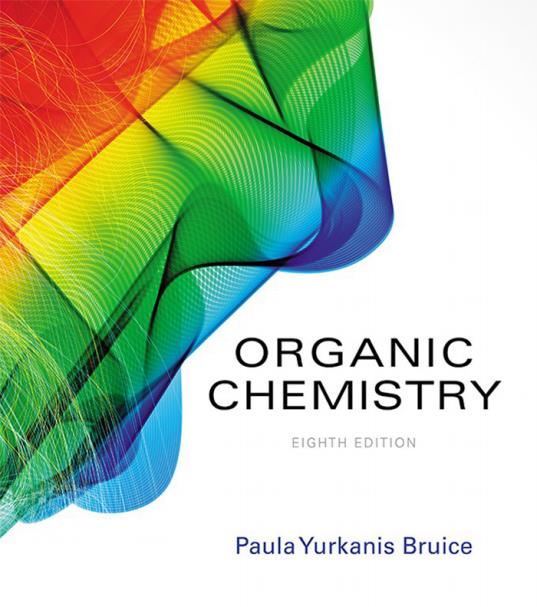
ORGANIC CHEMISTRY EIGHTH EDITION Paula Yurkanis Bruice
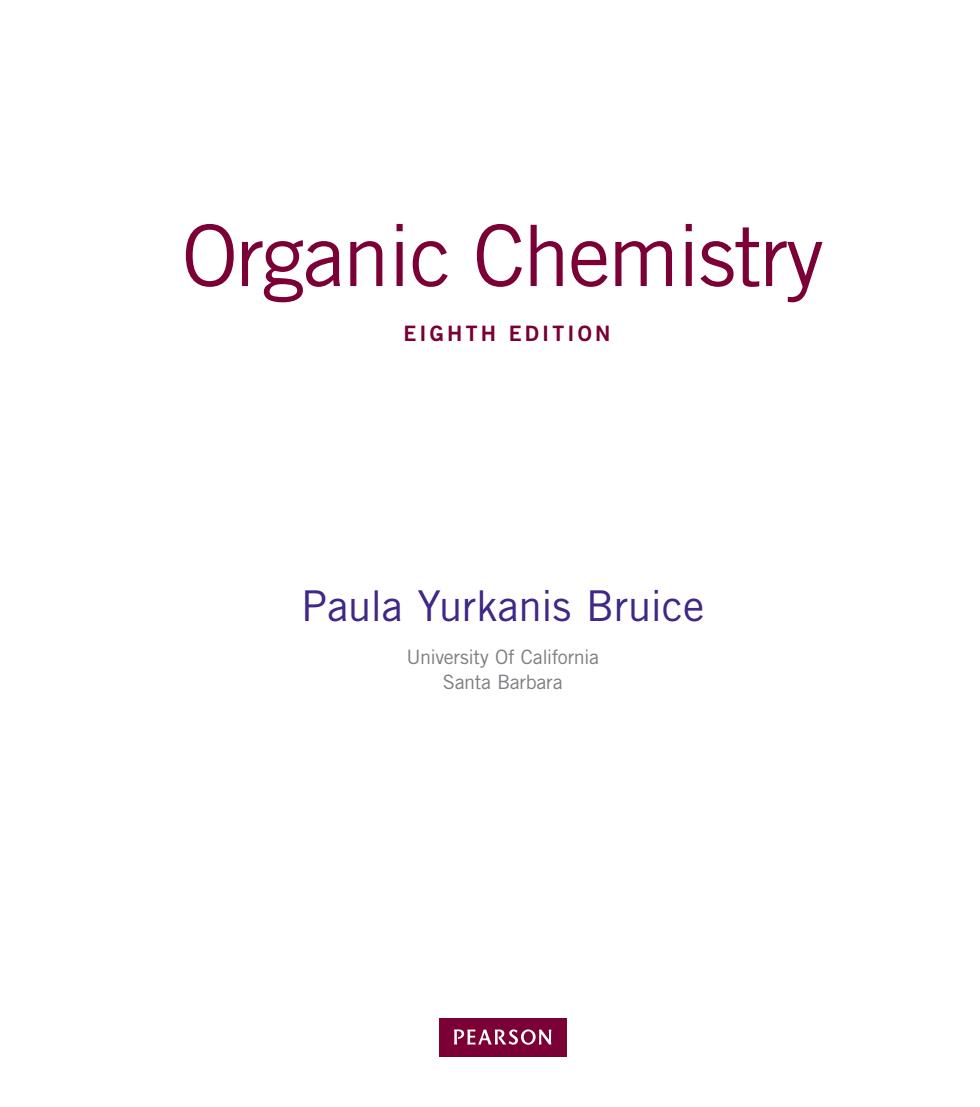
Organic Chemistry EIGHTH EDITION Paula Yurkanis Bruice University Of California Santa Barbara PEARSON
Organic Chemistry EIGHTH EDITION Paula Yurkanis Bruice University Of California Santa Barbara
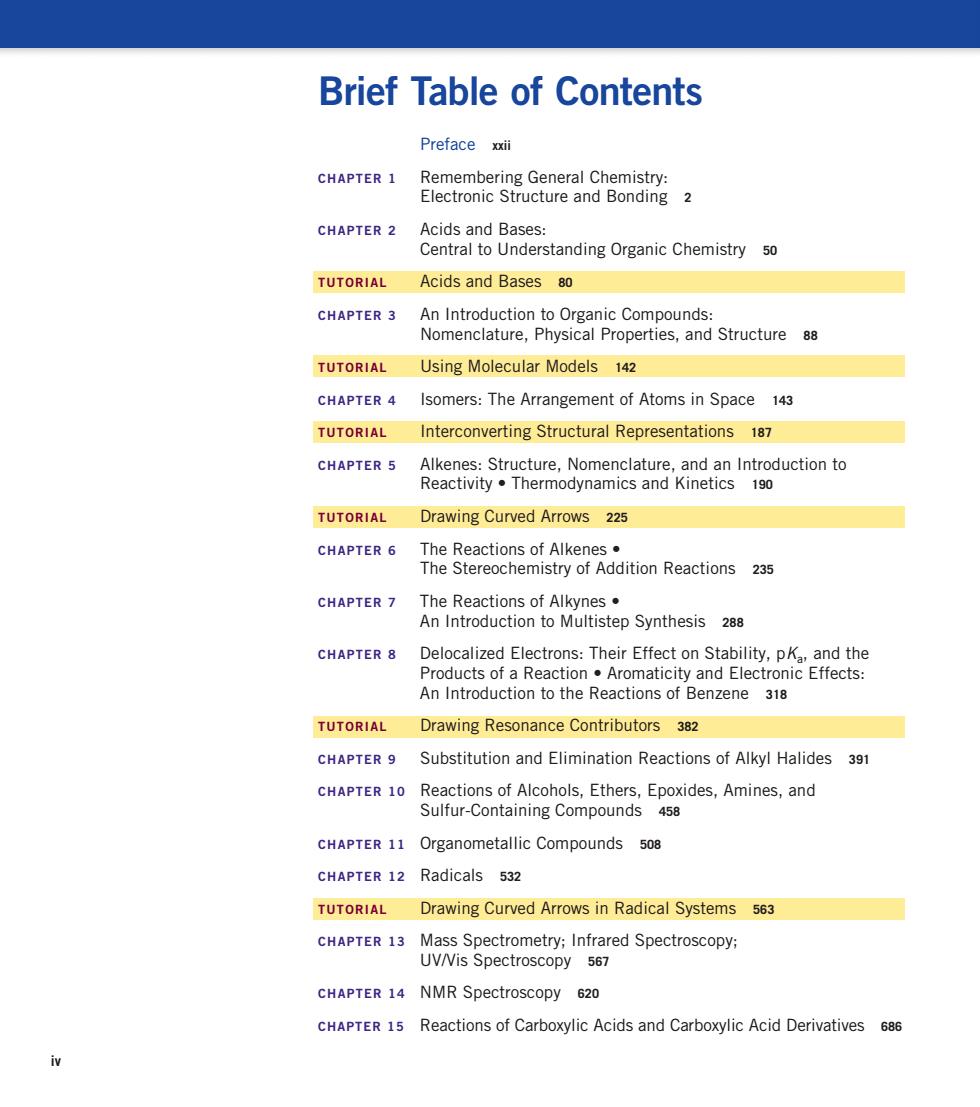
Brief Table of Contents Preface xxii CHAPTER 1 Remembering General Chemistry: Electronic Structure and Bonding 2 CHAPTER 2 Acids and bases Central to Understanding Organic Chemistry 50 TUTORIAL Acids and Bases 8o CHAPTER 3 An Introduction to organic compounds: Nomenclature,Physical Properties,and Structure 88 TUTORIAL Using Molecular Models 142 CHAPTER 4 Isomers:The Arrangement of Atoms in Space 143 TUTORIAL Interconverting Structural Representations 187 CHAPTER 5 Alkenes:Structure,Nomenclature,and an Introduction to Reactivity.Thermodynamics and Kinetics 190 TUTORIAL Drawing Curved Arrows 225 CHAPTER 6 The Reactions of Alkenes. The Stereochemistry of Addition Reactions 235 CHAPTER 7 The Reactions of Alkynes. An Introduction to Multistep Synthesis 288 CHAPTER 8 Delocalized Electrons:Their Effect on Stability,pKa,and the Products of a Reaction.Aromaticity and Electronic Effects: An Introduction to the Reactions of Benzene 318 TUTORIAL Drawing Resonance Contributors 382 CHAPTER 9 Substitution and Elimination Reactions of Alkyl Halides 391 CHAPTER 10 Reactions of Alcohols,Ethers,Epoxides,Amines,and Sulfur-Containing Compounds 458 CHAPTER 11 Organometallic Compounds 508 CHAPTER 12 Radicals 532 TUTORIAL Drawing Curved Arrows in Radical Systems 563 CHAPTER 13 Mass Spectrometry:Infrared Spectroscopy; UV/Vis Spectroscopy 567 CHAPTER 14 NMR Spectroscopy 620 CHAPTER 15 Reactions of Carboxylic Acids and Carboxylic Acid Derivatives 686 iv
iv Brief Table of Contents Preface xxii CHAPTER 1 Remembering General Chemistry: Electronic Structure and Bonding 2 CHAPTER 2 Acids and Bases: Central to Understanding Organic Chemistry 50 TUTORIAL Acids and Bases 80 CHAPTER 3 An Introduction to Organic Compounds: Nomenclature, Physical Properties, and Structure 88 TUTORIAL Using Molecular Models 142 CHAPTER 4 Isomers: The Arrangement of Atoms in Space 143 TUTORIAL Interconverting Structural Representations 187 CHAPTER 5 Alkenes: Structure, Nomenclature, and an Introduction to Reactivity • Thermodynamics and Kinetics 190 TUTORIAL Drawing Curved Arrows 225 CHAPTER 6 The Reactions of Alkenes • The Stereochemistry of Addition Reactions 235 CHAPTER 7 The Reactions of Alkynes • An Introduction to Multistep Synthesis 288 CHAPTER 8 Delocalized Electrons: Their Effect on Stability, pKa, and the Products of a Reaction • Aromaticity and Electronic Effects: An Introduction to the Reactions of Benzene 318 TUTORIAL Drawing Resonance Contributors 382 CHAPTER 9 Substitution and Elimination Reactions of Alkyl Halides 391 CHAPTER 10 Reactions of Alcohols, Ethers, Epoxides, Amines, and Sulfur-Containing Compounds 458 CHAPTER 11 Organometallic Compounds 508 CHAPTER 12 Radicals 532 TUTORIAL Drawing Curved Arrows in Radical Systems 563 CHAPTER 13 Mass Spectrometry; Infrared Spectroscopy; UV/Vis Spectroscopy 567 CHAPTER 14 NMR Spectroscopy 620 CHAPTER 15 Reactions of Carboxylic Acids and Carboxylic Acid Derivatives 686
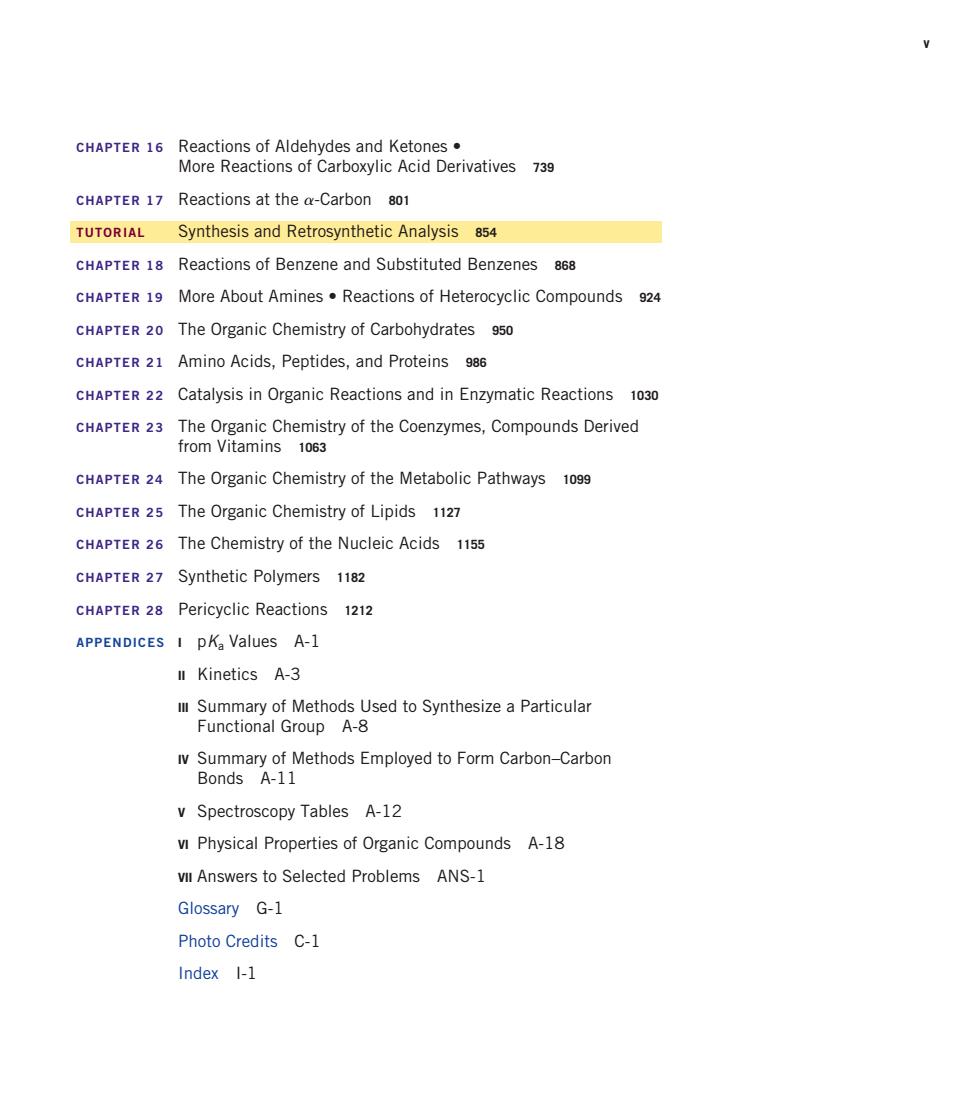
CHAPTER 16 Reactions of Aldehydes and Ketones. More Reactions of Carboxylic Acid Derivatives 739 CHAPTER 17 Reactions at the a-Carbon 801 TUTORIAL Synthesis and Retrosynthetic Analysis 854 CHAPTER 18 Reactions of Benzene and Substituted Benzenes 868 CHAPTER 19 More About Amines.Reactions of Heterocyclic Compounds 924 CHAPTER 20 The Organic Chemistry of Carbohydrates 950 CHAPTER 21 Amino Acids,Peptides,and Proteins 986 CHAPTER 22 Catalysis in Organic Reactions and in Enzymatic Reactions 1030 CHAPTER 23 The Organic Chemistry of the Coenzymes,Compounds Derived from Vitamins 1063 CHAPTER 24 The Organic Chemistry of the Metabolic Pathways 1099 CHAPTER 25 The Organic Chemistry of Lipids 1127 CHAPTER 26 The Chemistry of the Nucleic Acids 1155 CHAPTER 27 Synthetic Polymers 1182 CHAPTER 28 Pericyclic Reactions 1212 APPENDICES I pKa Values A-1 IIKinetics A-3 Iv Summary of Methods Employed to Form Carbon-Carbon Bonds A-11 v Spectroscopy Tables A-12 vI Physical Properties of Organic Compounds A-18 vul Answers to Selected Problems ANS-1 Glossary G-1 Photo Credits C-1 Index I-1
CHAPTER 16 Reactions of Aldehydes and Ketones • More Reactions of Carboxylic Acid Derivatives 739 CHAPTER 17 Reactions at the a-Carbon 801 TUTORIAL Synthesis and Retrosynthetic Analysis 854 CHAPTER 18 Reactions of Benzene and Substituted Benzenes 868 CHAPTER 19 More About Amines • Reactions of Heterocyclic Compounds 924 CHAPTER 20 The Organic Chemistry of Carbohydrates 950 CHAPTER 21 Amino Acids, Peptides, and Proteins 986 CHAPTER 22 Catalysis in Organic Reactions and in Enzymatic Reactions 1030 CHAPTER 23 The Organic Chemistry of the Coenzymes, Compounds Derived from Vitamins 1063 CHAPTER 24 The Organic Chemistry of the Metabolic Pathways 1099 CHAPTER 25 The Organic Chemistry of Lipids 1127 CHAPTER 26 The Chemistry of the Nucleic Acids 1155 CHAPTER 27 Synthetic Polymers 1182 CHAPTER 28 Pericyclic Reactions 1212 APPENDICES I pKa Values A-1 II Kinetics A-3 III Summary of Methods Used to Synthesize a Particular Functional Group A-8 IV Summary of Methods Employed to Form Carbon–Carbon Bonds A-11 V Spectroscopy Tables A-12 VI Physical Properties of Organic Compounds A-18 VII Answers to Selected Problems ANS-1 Glossary G-1 Photo Credits C-1 Index I-1 v
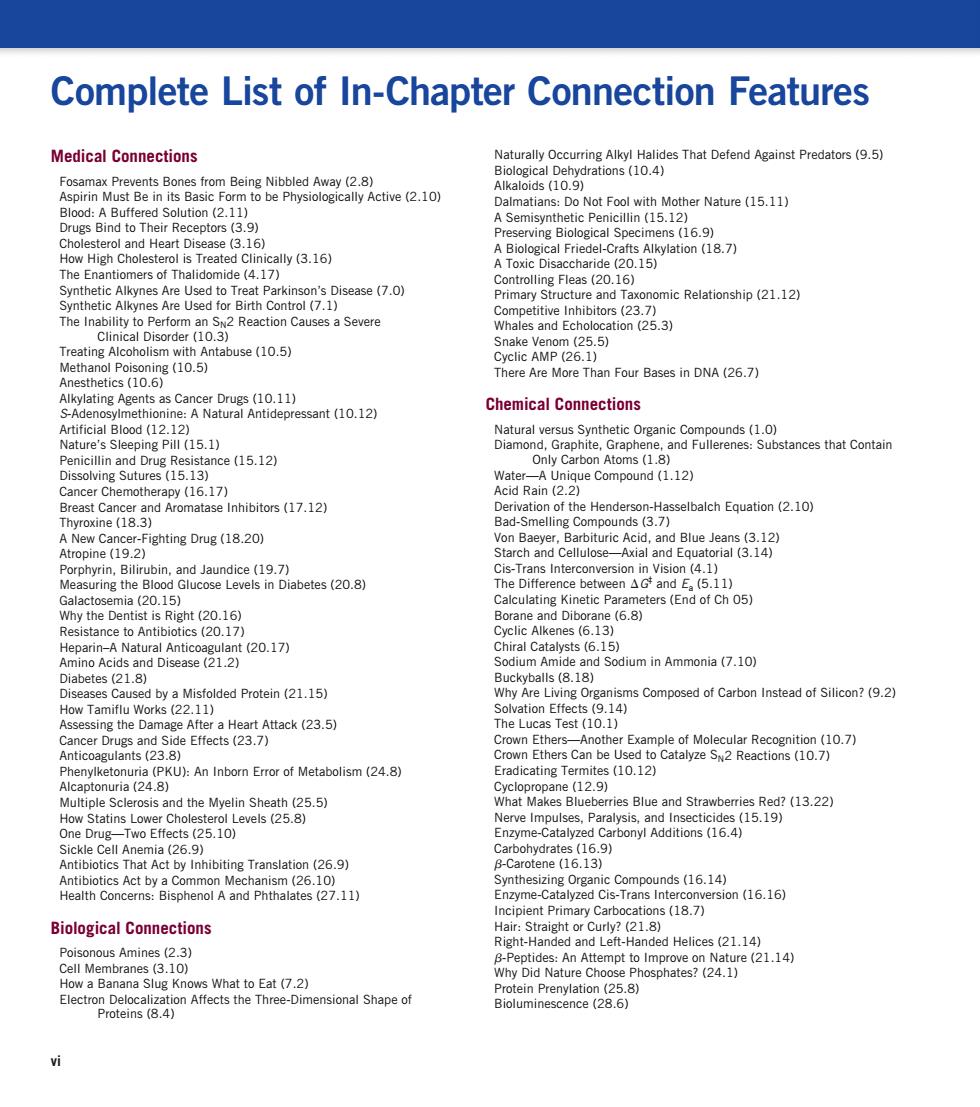
Complete List of In-Chapter Connection Features Medical Connections Naturally Occurring Alkyl Halides That Defend Against Predators(9.5) Aieocl08gdratonsao.4y to be Physiologically Active(2.10) Dalmatians:Do Not Fool with Mother Nature (51 in (3) tic Penicillin (15.12 () 16Q e3. clinically (3.16) A Biol The Enantiomers of Thalidomide(4.17) A Toxic Dis 215 Alkynes Are Used Disease(7.0) omic Relationship(21.12) SN2 Reaction Causes a Severe Snake Venom (2.5) More Than Four Bases in DNA(26.7) Natura (1.12) Chemical Connections Natural ds (1 Nature's Sleeping Pill (15.1) Wate 0d1.12 Cancer Chemotherapy(16.17) Acid Rain(2.2) () (2.10) Cis-Trans Intere ersion in vision t 1 05 Borane and Diborane (6.8) Resistance to Antibiot (20.17 min (20.17 Sodium Amide and Sodium in Ammonia(710) Diabetes(21) a Misfolded Protein(21.15) s Composed of Carbon Instead of Silicon?(9.2) How Tamiflu Works(22.11) .) Test (10.1 n(10.7 Anticoagulants (23.8) 12.91 10.12 Multiple Sclerosis and the Myelin Sheath(25.5) (2510) evels (25.8) hydrates(16.9) Antibiotic 266.9 ic Compounds (16.14) alyzed ntp Gdcaiieg87esiona6.16) Biological Connections Hair:Straight orC y2(21.8 Right-Handed and Left-Handed Helices(21.14) e(21.14) ows What to Eat (7.2) on Affects the Three-Dimensional Shape of Protein Prenylatio 2868 i
vi Medical Connections Fosamax Prevents Bones from Being Nibbled Away (2.8) Aspirin Must Be in its Basic Form to be Physiologically Active (2.10) Blood: A Buffered Solution (2.11) Drugs Bind to Their Receptors (3.9) Cholesterol and Heart Disease (3.16) How High Cholesterol is Treated Clinically (3.16) The Enantiomers of Thalidomide (4.17) Synthetic Alkynes Are Used to Treat Parkinson’s Disease (7.0) Synthetic Alkynes Are Used for Birth Control (7.1) The Inability to Perform an SN2 Reaction Causes a Severe Clinical Disorder (10.3) Treating Alcoholism with Antabuse (10.5) Methanol Poisoning (10.5) Anesthetics (10.6) Alkylating Agents as Cancer Drugs (10.11) S-Adenosylmethionine: A Natural Antidepressant (10.12) Artificial Blood (12.12) Nature’s Sleeping Pill (15.1) Penicillin and Drug Resistance (15.12) Dissolving Sutures (15.13) Cancer Chemotherapy (16.17) Breast Cancer and Aromatase Inhibitors (17.12) Thyroxine (18.3) A New Cancer-Fighting Drug (18.20) Atropine (19.2) Porphyrin, Bilirubin, and Jaundice (19.7) Measuring the Blood Glucose Levels in Diabetes (20.8) Galactosemia (20.15) Why the Dentist is Right (20.16) Resistance to Antibiotics (20.17) Heparin–A Natural Anticoagulant (20.17) Amino Acids and Disease (21.2) Diabetes (21.8) Diseases Caused by a Misfolded Protein (21.15) How Tamiflu Works (22.11) Assessing the Damage After a Heart Attack (23.5) Cancer Drugs and Side Effects (23.7) Anticoagulants (23.8) Phenylketonuria (PKU): An Inborn Error of Metabolism (24.8) Alcaptonuria (24.8) Multiple Sclerosis and the Myelin Sheath (25.5) How Statins Lower Cholesterol Levels (25.8) One Drug—Two Effects (25.10) Sickle Cell Anemia (26.9) Antibiotics That Act by Inhibiting Translation (26.9) Antibiotics Act by a Common Mechanism (26.10) Health Concerns: Bisphenol A and Phthalates (27.11) Biological Connections Poisonous Amines (2.3) Cell Membranes (3.10) How a Banana Slug Knows What to Eat (7.2) Electron Delocalization Affects the Three-Dimensional Shape of Proteins (8.4) Naturally Occurring Alkyl Halides That Defend Against Predators (9.5) Biological Dehydrations (10.4) Alkaloids (10.9) Dalmatians: Do Not Fool with Mother Nature (15.11) A Semisynthetic Penicillin (15.12) Preserving Biological Specimens (16.9) A Biological Friedel-Crafts Alkylation (18.7) A Toxic Disaccharide (20.15) Controlling Fleas (20.16) Primary Structure and Taxonomic Relationship (21.12) Competitive Inhibitors (23.7) Whales and Echolocation (25.3) Snake Venom (25.5) Cyclic AMP (26.1) There Are More Than Four Bases in DNA (26.7) Chemical Connections Natural versus Synthetic Organic Compounds (1.0) Diamond, Graphite, Graphene, and Fullerenes: Substances that Contain Only Carbon Atoms (1.8) Water—A Unique Compound (1.12) Acid Rain (2.2) Derivation of the Henderson-Hasselbalch Equation (2.10) Bad-Smelling Compounds (3.7) Von Baeyer, Barbituric Acid, and Blue Jeans (3.12) Starch and Cellulose—Axial and Equatorial (3.14) Cis-Trans Interconversion in Vision (4.1) The Difference between ∆G‡ and Ea (5.11) Calculating Kinetic Parameters (End of Ch 05) Borane and Diborane (6.8) Cyclic Alkenes (6.13) Chiral Catalysts (6.15) Sodium Amide and Sodium in Ammonia (7.10) Buckyballs (8.18) Why Are Living Organisms Composed of Carbon Instead of Silicon? (9.2) Solvation Effects (9.14) The Lucas Test (10.1) Crown Ethers—Another Example of Molecular Recognition (10.7) Crown Ethers Can be Used to Catalyze SN2 Reactions (10.7) Eradicating Termites (10.12) Cyclopropane (12.9) What Makes Blueberries Blue and Strawberries Red? (13.22) Nerve Impulses, Paralysis, and Insecticides (15.19) Enzyme-Catalyzed Carbonyl Additions (16.4) Carbohydrates (16.9) b-Carotene (16.13) Synthesizing Organic Compounds (16.14) Enzyme-Catalyzed Cis-Trans Interconversion (16.16) Incipient Primary Carbocations (18.7) Hair: Straight or Curly? (21.8) Right-Handed and Left-Handed Helices (21.14) b-Peptides: An Attempt to Improve on Nature (21.14) Why Did Nature Choose Phosphates? (24.1) Protein Prenylation (25.8) Bioluminescence (28.6) Complete List of In-Chapter Connection Features